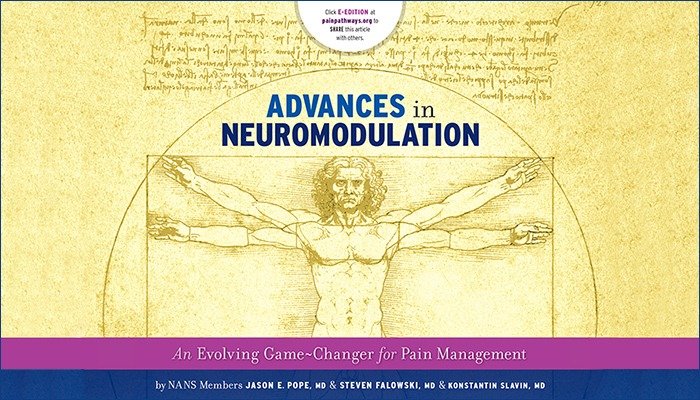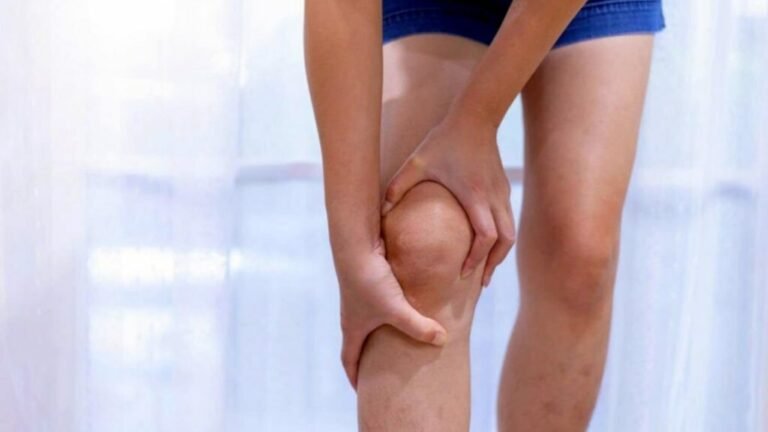Advances in Neuromodulation

Approximately one in three Americans suffers from chronic pain, leading to escalating health care costs and a growing interest in treating chronic pain sustainably, but managing pain is a complex pursuit.
The longer patients experience pain, the more reinforced it is (a concept known as central sensitization), thus introducing a “moving target.” Historically, physicians turned to opioid-based analgesics in an attempt to manage chronic pain—medications like hydrocodone andoxycodone.2 Unfortunately, success did not follow.
Patients commonly report that a dose of hydrocodone that was once helpful becomes less effective over time, with the common solution of dose escalation. Unfortunately, the “behind the scenes” consequences of opioids, including the influence of decreasing wound healing and reducing hormone levels, such as testosterone, can have disastrous consequences, including promoting bone fragility that can lead to fracture, Table 1.3
Further, the challenges of prescription opioids have reached epidemic proportions, with over 16,000 deaths annually, with the US consuming 99 percent of the world hydrocodone supply.4 In 2009, the director of the Centers for Disease Control (CDC), Thomas Frieden, MD, recommended narcotics as a last resort for chronic pain management.5 This national attention has resulted in support for therapies that mitigate the need for opioid use, promoting a more healthy and sustained long-term strategy, Table 2. Although alternative chronic pain treatments have existed, it now seems that the pursuit of these modalities by the community has gained momentum.
These alternatives largely center on interventional techniques. Interventional nonsurgical options to treat chronic pain include augmentative or ablative techniques.
Ablative therapies are similar in concept to the ablation of an aberrant electrical pathway in the heart to treat certain arrhythmias. Augmentative therapies are conceptually similar to pacemakers, using electricity to activate nerves. This is the concept of neuromodulation. “Neuromodulation employs advanced medical device technologies to enhance or suppress activity of the nervous system for the treatment of disease. These technologies include implantable as well as non-implantable devices that deliver electrical, chemical, or other agents (such as light energy) to reversibly modify brain and nerve cell activity.”6 These therapies have been used to treat angina, epilepsy and most commonly, pain.
The concept of neuromodulation to manage chronic pain was fostered by Melzack and Wall, introducing the concept of the gate control theory.7 This basically describes the ability to inhibit the propagation of a pain signal by overwhelming it with augmenting another neural pathway. Although simplified, this conceptually explains one of the theories of neuromodulation, and more importantly, spinal cord stimulation. Spinal Cord Stimulation Spinal Cord Stimulation, courtesy of St. Jude Medical
TRADITIONAL SPINAL CORD STIMULATION
Spinal cord stimulation (SCS) is the use of electrodes, introduced into the epidural space, to stimulate certain targets to treat a variety of pain disorders using electricity. As a treatment, it is the number one indication in the world for people who continue to suffer from pain, despite having a spinal surgery, also termed “failed back surgery syndrome” (FBSS) or “post laminectomy sydrome.”8 SCS is also used to treat complex regional pain syndrome, or CRPS, a neuropathic disease process that can be the result of major or minor upper or lower limb injury, creating a constellation of symptoms including pain, swelling and sensitivity to touch (termed hyperalgesia or allodynia). It is also used in a variety of other disease processes.
How SCS Works
Typically, SCS creates a warm, pleasant tingling sensation overlying the typical area of pain. In order to determine if the therapy would be helpful for the long term, a trial is performed, usually executed through simple needle placement. The trial procedure is similar to the introduction of an epidural catheter in the setting of labor for childbirth, with a few important differences. First, patients are positioned on their stomachs prone) for placement during the trial. Second, a fluoroscope is utilized to obtain X-ray images in real time during placement of the trial leads. Lastly, the procedure is performed under local anesthesia, with the patients being discharged home immediately following the procedure.
The technology is very similar conceptually to a television, in that it can be turned on or off, the channel (or program) can be changed to better cover one area or another, and patients can adjust the volume as needed to treat their pain fluctuations. The strategy of using this pleasant sensation, or paresthesia, placed over the typical area of pain is termed “tonic stimulation.” Recently, the trial experience for the patient has been streamlined to include minimizing the necessary cables and bandages, allowing the patient to focus on the experience and less of the mechanics of the bandaging system.
The evidence surrounding its use is compelling. Randomized, controlled studies of patients with both back and leg pain following surgery, as compared to medical management or repeat operation, dramatically suggested, with statistical significance, that spinal cord stimulation is the treatment path of choice.9,10,11 Similarly, for complex regional pain syndrome, data suggest improvement in treatment as compared to conservative medical management.12,13
Salvage Therapy vs. Refractory Pain
Unfortunately, SCS therapy has sometimes been viewed as a salvage therapy that is only employed once all other therapies have failed.14 It is important to differentiate refractory pain treatment from salvage pain treatment.
Refractory pain treatment with these advanced therapies is more patient centric, as data suggest salvage placement reduces success dramatically while earlier intervention increases success rates.15 The definition of refractory pain better places the therapies in the pain care algorithm: “Pain is defined as refractory, regardless of etiology, when {1} multiple evidence-based biomedical therapies used in a clinically appropriate and accept-able fashion have failed to reach treatment goals that may include adequate pain reduction and/or improvement in daily functioning or have resulted in intolerable adverse effects, and when {2} psychiatric disorders and psychosocial factors that could influence pain outcomes have been assessed and appropriately addressed.”16 Further, although the up-front cost of spinal cord stimulation is higher than conservative medical management, at 2.5 years, spinal cord stimulation becomes more cost effective.17
3 ADVANCES IN STIMULATION THERAPY
As described, the traditional, tonic spinal cord stimulation has robust evidence to support its efficacy. However, as with any medical treatment, clinicians are looking for solutions to some of the perceived nuances of spinal cord stimulation. The approach to solve the concerns was more hardware than software.18
Most recently, the focus of SCS innovation has seen a paradigm shift to software, programming advancements and novel intraspinal targets. The most rigorously studied advancements include high-frequency stimulation (HF10), DeRidder’s Burst stimulation (DrBS) and Dorsal Root Ganglion (DRG) spinal stimulation. Each offers an exciting new approach: HF10offers paresthesia-free stimulation, or pain relief without the need to feel the previously described warm pleasant tingling sensation. DBrS offers paresthesia-free coverage, the ability to switch back to tonic stimulation, if desired, and the ability to stimulate a new pain pathway, one that reduces pain perception. DRG-SS offers a methodology to treat CRPS of the lower extremities, in areas that have been somewhat difficult to “cover” with traditional tonic stimulation. All these modalities underwent rigorous study, and we will briefly review their recent US pivotal trials.
{1} HIGH-FREQUENCY STIMULATION {HF10}
HF10, or high-frequency stimulation at 10,000Hz, was first introduced in2009. As a reference, tonic stimulation operates at frequencies of 10-100Hz. With an increased frequency comes an increased energy demand and recharging requirement. The mechanism of action may center on wide dynamic range neurons. Several studies have suggested superiority to traditional tonic stimulation for back and leg pain.19 Kapural et al. published the results of the comparative trial of HF10totraditionaltonic stimulation. The study included 10 US centers; 241 patients were enrolled, 198 randomized to either traditional SCS or HF10, and 171 implanted. The results are compelling.
The study followed patients for 12 months with primary end points at 3 months. There was a responder rate of 84 percent for those with back pain, as well as an 83 percent responder rate for those with leg pain. Interestingly, these results were carried through to the 12-month analysis. VAS pain scores decreased significantly more in the HF10 group compared to the tonic stimulation group. There was a 66 percent reduction in VAS scores for back pain in the HF10 group compared to45per-cent in the tonic stimulation group, and a 70 percent reduction in VAS scores for leg pain in the HF10 group compared to 48 percent in the tonic stimulation group. The important take-home point from this landmark trial was not only the superior efficacy demonstrated with a new waveform, but it also confirmed the efficacy we have experienced with tonic stimulation.20
{2} DERIDDER BURST STIMULATION {DRBS}
DrBS almost simultaneously began to suggest a potential advantage to SCS in European studies. Burst stimulation delivers 40Hz bursts with five spikes at 500Hz per burst. DrBS may offer an advantage by activating a different pathway in the brain, leading to a change in the patient’s perception of pain and their behavior. Tonic stimulation seemingly activates solely the lateral (perceptive) pathway, whereas DrBS stimulation also stimulates the medial (affective) pathway.
The pivotal US trial randomized 173 patients at 20 centers, comparing tonic SCS to DrBS. Although the data is still being acquired, anecdotal successes are staggering, and evidence will be presented at an upcoming national neuromodulation meeting, the North American Neuromodulation Society Meeting. The European data which has led to the US pivotal trial clearly demonstrates significant reductions in VAS scores for both back and limb pain, as well as significant reductions in McGill short-form scores, a reliable marker of quality and intensity of pain. In addition several studies have demonstrated its effectiveness in those patients with either failed tonic stimulation trials or those who have lost efficacy over time with tonic stimulation.20,21,22
{3} DORSAL ROOT GANGLION SPINAL STIMULATION {DRG-SS}
DRG-SS is novel in both waveform application and design. The dorsal root ganglion is a primary nerve center that impacts both normal and abnormal pain transmission. It is located in the spinal canal, immediately under the pedicle, before the nerve root exists the spine. When pain is transmitted, it lowers the energy required for the DRG to propagate a painful signal, and if an electrical signal is applied it reduces the cellular membrane’s excitability, which greatly impedes the aforementioned pain signal.23 The European study suggests a clear advantage of SCS for certain disease processes.24The US pivotal trial investigated CRPS of the iliac crest and below, including disorders of post-hernioraphy pain with injury of the illioinguinal nerve. The study randomized 153 patients 1:1 with traditional SCS and SRG-SS stimulation, with safety and efficacy measures at 3, 6 and 12 months. Once implanted, the data demonstrated 93 percent superiority to SCS for greater than 50 percent pain eduction in the affected extremity. This now opens the door to widen the spectrumof disorders that can be treated with neuromodulation and adds another resource for the treating physician. Placement of the DRG-SS lead
The Future of SCS
The impact of these new SCS therapies for people living with pain is dramatic. Rather than relying on poor methods that managed pain unsustainably, physicians now have the capacity to focus on individualizing pain therapy. Earlier intervention with improved technology has led to significantly improved success. As pain care continues to evolve, neuromodulation will continue to evolve to meet the demands. We now live in a world where the evidence surrounding pain care is as robust and grounded as other disciplines. {PP}
NOTE: For more information, visit the NANS advocacy portal at www.neuromodulation.org/Education.aspx.
REFERENCES
1 Institute of Medicine. Relieving pain in America: A blueprint for transforming prevention, care, education, and research. 2011.
2 Petzke F, Welsch P, Klose P, Schaefert R, Sommer C, Häuser W. Opioids in chronic low back pain: A systematic review and meta-analysis of efficacy, tolerability and safety in randomized placebo-controlled studies of at least 4 weeks duration. Schmerz. 2015 Feb; 29(1):60-72. doi: 10.1007/s00482-014-1449-8. German. PMID:25503883.
3 Trescot AM, Datta S, Lee M, Hanes H. Opioid Pharmacology. Pain Physician 2008: Opioid Special Issue; 11:s133-153.
4 Manchikanti L, Fellows B, Ailinani H, et al. Therapeutic use, abuse, and nonmedical use of opioids: a ten-year perspective. Pain Physician. 2010 Sep-Oct; 13(5):401-35.5 Available from URL: http://articles.nydailynews.com/2011-11-01/news/30348003_1_prescription-drug-abuse-epidemic-overdose-deaths-painkillers.
6 Deer, TR, Krames, E, Mekhail, N, Pope, J, et al. Appropriate Use of Neurostimulation: New and Evolving NeurostimulationTherapies and Applicable Treatment for Chronic Pain and Selected Disease States. Neuromodulation: Technology at the Neural Interface, 17:599-615.doi:10.1111/ner.12204.
7 Melzack R, Wall PD. Pain Mechanisms: a new theory. Science 1965;150:971-79.
8 Deer T, Pope J, Hayek S, Narouze S, Patil P, Foreman R, Sharan A, Levy R. Neurostimulation for the treatment of axial back pain: a review of mechanisms, techniques, outcomes, and future advances. Neuromodulation. 2014 Oct; 17 Suppl 2:52-68. doi:10.1111/j.1525-1403.2012.00530.x.
9 North RB, Kidd DH, Farrokhi F, Piantadosi SA. Spinal cord stimulation versus repeated lumbosacral spine surgery for chronic pain: A randomized, controlled trial. Neurosurgery 2005;56:98-107.
10 Kumar K, Taylor RS, Jacques L, Eldabe S, Meglio M, Molet J, Thomson S, O’Callaghan J, Eisenberg E, Milbouw G, Buchser E, Fortini G, Richardson J, North RB. Spinal cord stimulation versus conventional medical management for neuropathic pain: A multicentre randomized controlled trial in patients with failed back surgery syndrome. Pain 2007; 132:179-188.
11 Kumar K, Taylor RS, Jacques L, Eldabe S, Meglio M, Molet J, Thomson S, O’Callaghan J, Eisenberg E, Milbouw G, Buchser E, Fortini G, Richardson J, North RB. The effects of spinal cord stimulation in neuropathic pain are sustained: A 24-month follow-up of the prospective randomized controlled multicenter trial of the effectiveness of spinal cord stimulation. Neurosurgery 2008; 63:762-770.
12 Kemler MA, Reulen JP, Barendse GA, van Kleef M, de Vet HC, van den Wildenberg FA. Impact of spinal cord stimulation on sensory characteristics in complex regional pain syndrome type I: a randomized trial. Anesthesiology 2001;95:72-80.
13 Kemler MA, De Vet HCW, Barendse GAM, Van Den Wildenberg FAJM, Van Kleef M. The effect of spinal cord stimulation in patients with chronic reflex sympathetic dystrophy: two years follow-up of the randomized controlled trial. Ann Neurol 2004; 55:13-8.
14 Porree L, Krames E, Pope J, Deer TR, Levy R, Schultz L. Spinal Cord Stimulation as Treatment for Complex Regional Pain Syndrome Should Be Considered Earlier than Last Resort Therapy. Neuromodulation 2013 Feb 26.doi:10.1111/ner.12035.
15 Kumar K, Hunter G, Demeria D. Spinal Cord stimulation in treatment of chronic benign pain: challenges in treatment planning and present status: a 22-year experience. Neurosurgery 2006.58:481-96.
16 Deer TR, Caraway DL, Wallace MS. A definition of refractory pain to help determine suitability for device implantation. Neuromodulation 2014; 17:711-5.
17 Kumar K, Rizvi S. Cost-effectiveness of spinal cord stimulation therapy in management of chronic pain. Pain Medicine. 2013.Nov; 14 (11):1631-49.
18 Pope J, Falowski S, Deer T. Advanced Waveforms and Frequency with Spinal Cord Stimulation: Burst and High-Frequency Energy Delivery. Expert Rev Med Devices. 2015Apr 6:1-7.
19 Kapural L, Yu C, Doust MW, et al. Novel 10-kHz Hi-Frequency Therapy (HF10) Is Superior to Traditional Low-Frequency Spinal Cord Stimulation for the Treatment of Chronic Back and Leg Pain. Anesthesiology. 2015. Vol 123, No.4, 1-10.
20 De Ridder D, Vanneste S, Plaizer M, van der Loo E, Menovsky T. Burst Spinal Cord Stimulation: Toward Paresthesia-free Pain Suppression. Neurosurgery 2010;May 66 (5): 986-90.
21 De Ridder D, Plaizer M, Kamerling N, Menovsky T, Vanneste S. Burst Spinal Cord Stimulation for Limb and Back Pain. World Neurosurg 2013 Jan 12.
22 De Vos CC, Bom MJ, Vanneste S, Lenders M, de Ridder D. Burst Spinal Cord Stimulation Evaluated in Patients with Failed Back Surgery Syndrome and Painful Diabetic Neuropathy. Neuromodulation 2013.
23 Koopmeiners AS, Mueller S, Kramer J. Effect of electrical field stimulation on dorsal root ganglion neuronal function. Neuromodulation. 2013Jul-Aug; 16(4):304-11; discussion 310-1. doi: 10.1111/ner.12028. Epub 2013Feb 19.
24 Liem L, Russo M, Huygen FJ, Van Buyten JP, Smet I, et al. A Multicenter, Prospective Trial to Assess the Safety and Performance of the Spinal Modulation Dorsal Root Ganglion Neurostimulator System in the Treatment of Chronic Pain. Neuromodulation 2013Sep-Oct; 16(5): 471-82; discussion 482
PainPathways Magazine
PainPathways is the first, only and ultimate pain magazine. First published in spring 2008, PainPathways is the culmination of the vision of Richard L. Rauck, MD, to provide a shared resource for people living with and caring for others in pain. This quarterly resource not only provides in-depth information on current treatments, therapies and research studies but also connects people who live with pain, both personally and professionally.
View All By PainPathways







